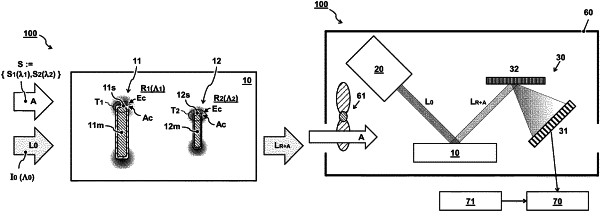| CPC G01N 21/3504 (2013.01) [G01N 21/21 (2013.01); G01N 21/554 (2013.01); G01N 21/658 (2013.01)] | 17 Claims |

|
1. An analyte detector comprising:
at least one substrate with a plurality of nano-antennas configured to receive a target analyte with a spectral signature having absorption peaks at different signature wavelengths,
a light source configured to provide a source light having a source intensity over a source wavelength range including different source light wavelengths for interaction with the target analyte at the different signature wavelengths according to the spectral signature; and
a light sensor for detecting a spectrum of the different source light wavelengths of the light having interacted with the target analyte at the different signature wavelengths for determining the spectral signature of the target analyte;
wherein the nano-antennas comprise an antenna material forming resonant antenna structures configured to receive and resonantly interact with the source light to form a respective resonance peak over a resonant wavelength range overlapping a respective signature wavelength of the target analyte,
wherein the resonant interaction with the source light causes a locally concentrated field of the source light in the resonant wavelength range,
wherein the locally concentrated field is localized around a respective target location of the nano-antennas and/or substrate;
wherein the target location is provided with a sorption material for sorbing the target analyte to provide a locally increased analyte concentration of the target analyte coinciding with the locally concentrated field of the source light for enhancing the interaction of the source light with the target analyte;
wherein different ones of the nano-antennas with the same sorption material in their respective target locations are configured to provide respective resonance peaks in different resonant wavelength ranges to overlap the different signature wavelengths of the spectral signature; and
wherein the analyte detector further comprises a spectrum analyzer configured to identify the target analyte by a spectral signature of the target analyte in different resonant wavelength ranges.
|